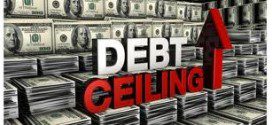The argument that the past 10 years of low interest rates has just been an anomaly  which will normalize to higher levels in the next couple of years is not going to unfold. Interest rates will be perpetually low for the rest of our lives! Here’s why.
which will normalize to higher levels in the next couple of years is not going to unfold. Interest rates will be perpetually low for the rest of our lives! Here’s why.
- The green line above represents our total debt as a percentage of GDP;
- the purple line is the historic 10 yr Treasury Note rate which we are using as a proxy for the average interest rate on total debt (AIR) and
- the blue line is the interest payment on our total debt as a percentage of GDP (again using the 10 yr rate as a proxy for average interest rate on total debt) let’s call it DSGDP.
- (The above relationships were regressed and found to be both statistical significant and with good explanatory properties.)
- total debt as a percentage of GDP (green line) recently exceeded 100% and,
- as the green line increases, the spread between the purple and blue lines gets smaller. This is really just an algebraic principle. Historically the blue line is essentially a fixed rate (within a range) and so as the green line moves up the purple line (AIR) must move down so the DSGDP stays within the fixed range.
- as total debt became a higher percentage of GDP the average interest rate on debt must move down toward that 2.5% line that we’ve held for 15 years.
- As the total debt to GDP moves above 100% (and even the CBO is forecasting debt to GDP to continue rising for as far as the eye can see) we will start to see the average interest rate on total debt (the purple line) move below 2.5% in order to keep the DSGDP around the 2.5% 15 year average.
In the future:
- If average interest rates on debt were to move back to the 20 yr average of 7.5% then our interest payments would take up 7.5% to 10% of our GDP – and that is something we simply cannot afford.
- The most our average interest on total debt can move in the near term is to around 4% which would take us to the high end of the historic DSGDP range…
- In 5 or 10 years time total debt will be sufficiently more than GDP that even 4% will be unsustainably high.
Editor’s Note: The author’s views and conclusions in the above article are unaltered and no personal comments have been included to maintain the integrity of the original post. Furthermore, the views, conclusions and any recommendations offered in this article are not to be construed as an endorsement of such by the editor.
If you liked this article then “Follow the munKNEE” & get each new post via
- Our Newsletter (sample here)
- Twitter (#munknee)
Interest rates will not rise again in our lifetime. Why, you ask? Because the leverage in the system would collapse the very financial assets and governments which underpin the global financial systems. It is INFLATE or DIE and it provides the additional benefit of feeding insolvent welfare states and the socialist politicians to feed their “useful idiot” supporters. Today’s missive will put some meaning into that observation. Read More »
2. Borrowing Binge & Asset Bubble to Continue Until…Until
History strongly suggests that, rather than a return to a nice, placid world of “normal” interest rates, we are likely to see a continuation of the borrowing binge/asset bubble until real rates spike as a result of either soaring nominal rates soar or plummeting inflation. Here’s why that is the case. Read More »
3. Don’t Fear End of QE or Beginning of Higher Interest Rates – Here’s Why
The Fed and the bond market are responding appropriately to declining risk aversion and a somewhat improved economic outlook. There is no reason to fear the end of QE or the beginning of higher short-term interest rates. Let me explain further. Read More »
4. Interest Rates to Remain Low As Far As the Eye Can See? Perhaps, BUT
Everyone knows that interest rates are going to rise in the future so the real question is not whether they will rise, but when and by how much. [This article analyzes when that will most likely be.] Read More »
5. Higher Interest Rates Will Come Once These 4 Economic Conditions Are Met
4 economic conditions need to be in place for interest rates to rise ahead of – and independent of – the Fed’s forward guidance. The economy met only one of those conditions to date but will likely meet all four by the end of the year…What follows is a status report on the four conditions. Read More »
6. Interest Rates NOT Rising Any Time Soon – Even With Fed Tapering. Here’s Why
Everyone and their mom is expecting long-term interest rates to rise now that the Fed is tapering its bond buying programs. I have a couple of problems with this line of thinking because, although it seems like reducing demand for a security (i.e. tapering QE) would result in a drop in price, when you really think about how quantitative easing works this makes no sense and, secondly, the market is telling us this makes no sense. Let me explain. Read More »
7. We Will Experience the Anguish of Severe Inflation In the Coming Years – Here’s Why
The Fed’s buying of U.S. Treasuries by creating currency (paper money) out of thin air is inflationary (either now or long term) and those that do not accept this premise are, with all due respect, daft, and is sure to result in a momentous growth in the value of hard assets such as gold and silver. Here’s why. Read More »
8. Inflation Will Become a Huge & Growing Problem Beginning In 2015 – Here’s Why
A temporary period of deflation will result from the end of the Fed’s massive asset purchases followed by a period of inflation that will make the ’70s seem like an era of hard money. Here’s why. Read More »
9. High Inflation IS Coming – It’s Just A Question Of When – Here’s Why
There have been many econoblog posts of the form, “ha, ha, the people predicting inflation have been wrong so far, when will they give up?”. Let me try to explain why we know high inflation is coming eventually. Read More »
10. What Affect Will Rising Interest Rates Have On Inflation & the Future Price of Gold?Though the stock, bond and currency markets, at the moment, are preoccupied with the question of when the first interest-rate increase will happen, the real story lies in where interest rates are ultimately headed because that answer defines where stock, bond and currency prices are ultimately headed and the reality, dear reader, is that the Fed simply cannot — and will not — allow interest rates to crawl very high. Why is that you ask? Read on! Read More »
 munKNEE.com Your Key to Making Money
munKNEE.com Your Key to Making Money



